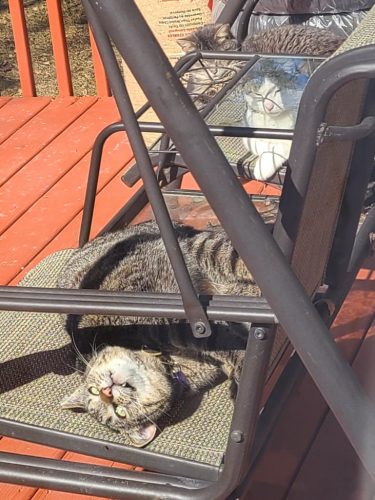By: Talin Seta Shahinian
We think of our cats as members of our family. Some of us talk to our cats, and they answer us too, well, in meows anyway. The truth is they’re also prone to some of the same diseases as human beings. For example, cats can have diabetes, and the illness in felines is much the same as it is in people.
What Is Diabetes?

Diabetes impairs a cat’s ability to produce the hormone insulin or regulate its insulin response. The pancreas secretes insulin. In cats, the pancreas is located mid-abdomen, below the stomach. Insulin is a vital hormone. When functioning correctly, it lowers sugar levels in the blood by moving it from the bloodstream to the cells to be utilized. The proper glucose level, or blood sugar, is important, as it’s a significant energy source for your cat’s cells. If insulin is imbalanced, it can impact your cat’s overall health and energy levels.
As in humans, cats can have Type 1 diabetes or Type 2 diabetes. In either case, it results in the abnormal metabolism of carbohydrates and leads to elevated glucose levels, or high blood sugar, within his blood and urine. If this is caused by Type 1 diabetes, it means his body can’t make insulin. This inability to create insulin can be due to pancreatitis or genetic factors. In the case of Type 2 diabetes, it means his cells don’t normally respond to insulin. Type 2 diabetes is more common in cats. It’s also more likely to be seen in male cats than female cats.
What Are Some Signs of Diabetes in Cats?
Being aware of the warning signs of diabetes can help you identify and treat this illness more quidkly for your feline friend. Signs include:
- Increased thirst. It may be hard to notice this symptom, especially if you use an automatic water fountain for your cat. If you suspect this, switch to a regular water bowl for a while, and keep an eye on how fast it becomes empty.
- Increased urination. This symptom may be more evident if you notice your cat going to his litter box more often or when you go to scoop your cat’s litter box.
- Increased/Decreased Appetite. Some cats tend to be enthusiastic about all food, and some are picky eaters. Some have hearty appetites and chow down as much as they can, and some are less food motivated. So, considering your cat’s baseline behaviors around food, look for any changes in his appetite.
- Weight Loss. Your cat may start to lose weight, despite the amount of food he consumes.
- Weakness in Hind Legs/Limping. High blood sugar levels can affect the nerves in your cat’s back legs, causing him to walk oddly or have trouble jumping. This can also show up as plantigrade stance, where your cat walks on his heels instead of his toes.
- Lethargy. It may be tough to spot this symptom, as cats do nap quite a lot, but don’t write it off if your cat seems less energetic, and he doesn’t rouse, even at mealtimes.
Diabetes Risk Factors and Diabetes Prevention in Cats
Type 1 diabetes is a chronic illness that requires lifelong management. It’s not caused by factors that can be reversed through non-medical efforts, nor is there any way to prevent it. There are risk factors for Type 2 diabetes, such as obesity and long-term steroid use. If your cat has a medical condition that’s being treated with injected or oral steroids over a long period. This can put her at risk for Type 2 diabetes, as steroids disrupt insulin function. Helping your cat lose weight if she’s obese can lower her chance of developing type 2 diabetes.
How is Diabetes in Cats Diagnosed?
Your veterinarian will test the glucose levels in your cat’s blood and urine. Along with other observed symptoms, a high sugar level needs to be a persistent finding. A single glucose reading isn’t sufficient, as there can be temporary spikes in blood sugar levels. If there’s any uncertainty, your vet may opt for a lab test known as a fructosamine concentration, which shows your cat’s average blood glucose concentration over two weeks. Your vet may run other tests to rule out other medical conditions with any overlapping symptoms.
How is Diabetes in Cats Treated?

In most cases, whether your cat has been diagnosed with Type 1 or Type 2 diabetes, the treatment will be the same. They’ll be put on a regimen of daily or twice daily insulin injections that you’ll administer at home after being trained by your veterinarian and their staff. Your vet may prescribe a high-protein, low-carbohydrate diet and steer you toward feeding your kitty canned food, as it’s less calorically dense, lower in carbs, and contains more fluids. Your vet may also recommend establishing set feeding times and discourage you from letting your cat graze on kibble all day.
The Prognosis for Cats with Diabetes
Although receiving a Type 1 or Type 2 diabetes diagnosis for your cat can be scary to hear, it’s a manageable disease, and they can still live a full, long life. In the case of Type 2 diabetes, it may even be reversible; with medication, proper diet, and exercise, your cat could go into remission, so don’t lose hope. Encourage exercise through energetic forms of play with your cat, like having them chase a laser pointer, bat at a toy at the end of a pole, or take them for walks on a harness and leash.
If you live in NW Wisconsin, Purple Cat Mobile Vet Clinic is here to help you keep your cat healthy and happy. We’re a high-quality, high-volume, low-cost spay/neuter clinic. We see cats exclusively. Find information for scheduling on our www.purplecatvet.com website. You can also look on our Facebook page for more helpful information on all things feline!
